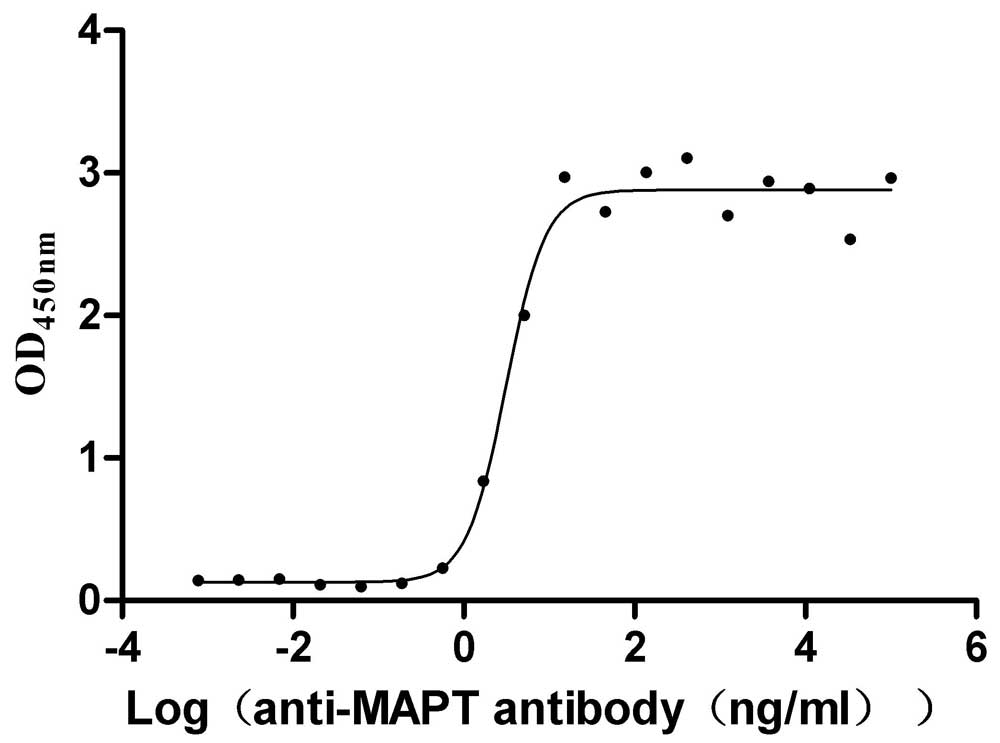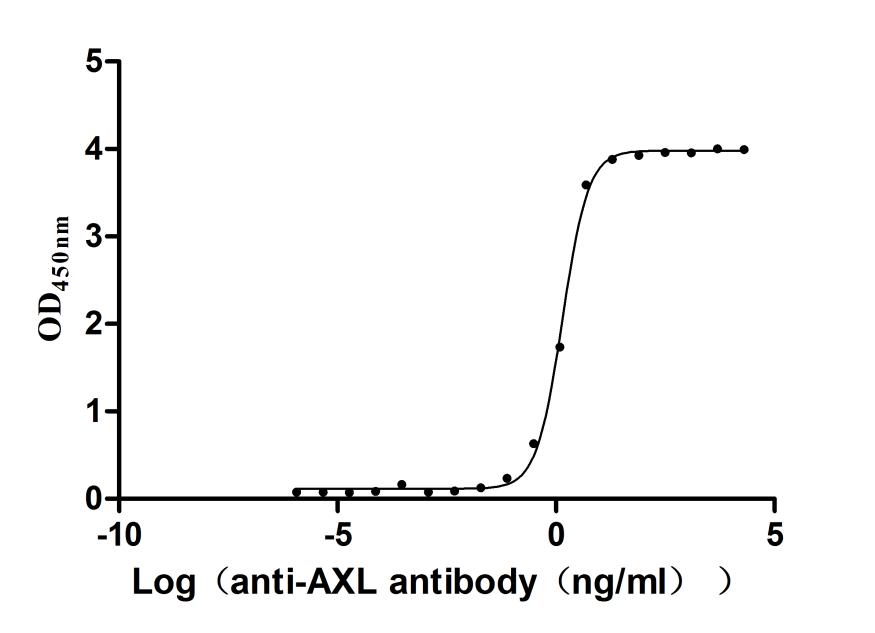Recombinant Human Cell cycle checkpoint control protein RAD9A (RAD9A)
-
中文名称:人RAD9A重组蛋白
-
货号:CSB-YP857455HU
-
规格:
-
来源:Yeast
-
其他:
-
中文名称:人RAD9A重组蛋白
-
货号:CSB-EP857455HU
-
规格:
-
来源:E.coli
-
其他:
-
中文名称:人RAD9A重组蛋白
-
货号:CSB-EP857455HU-B
-
规格:
-
来源:E.coli
-
共轭:Avi-tag Biotinylated
E. coli biotin ligase (BirA) is highly specific in covalently attaching biotin to the 15 amino acid AviTag peptide. This recombinant protein was biotinylated in vivo by AviTag-BirA technology, which method is BriA catalyzes amide linkage between the biotin and the specific lysine of the AviTag.
-
其他:
-
中文名称:人RAD9A重组蛋白
-
货号:CSB-BP857455HU
-
规格:
-
来源:Baculovirus
-
其他:
-
中文名称:人RAD9A重组蛋白
-
货号:CSB-MP857455HU
-
规格:
-
来源:Mammalian cell
-
其他:
产品详情
-
纯度:>85% (SDS-PAGE)
-
基因名:
-
Uniprot No.:
-
别名:Cell cycle checkpoint control protein; Cell cycle checkpoint control protein RAD9A; DNA repair exonuclease rad9 homolog A; hRAD 9; hRAD9; Rad 9; RAD 9A; RAD9 (S pombe) homolog ; RAD9 homolog A; RAD9 homolog; Rad9a; RAD9A_HUMAN
-
种属:Homo sapiens (Human)
-
蛋白长度:full length protein
-
表达区域:1-391
-
氨基酸序列MKCLVTGGNV KVLGKAVHSL SRIGDELYLE PLEDGLSLRT VNSSRSAYAC FLFAPLFFQQ YQAATPGQDL LRCKILMKSF LSVFRSLAML EKTVEKCCIS LNGRSSRLVV QLHCKFGVRK THNLSFQDCE SLQAVFDPAS CPHMLRAPAR VLGEAVLPFS PALAEVTLGI GRGRRVILRS YHEEEADSTA KAMVTEMCLG EEDFQQLQAQ EGVAITFCLK EFRGLLSFAE SANLNLSIHF DAPGRPAIFT IKDSLLDGHF VLATLSDTDS HSQDLGSPER HQPVPQLQAH STPHPDDFAN DDIDSYMIAM ETTIGNEGSR VLPSISLSPG PQPPKSPGPH SEEEDEAEPS TVPGTPPPKK FRSLFFGSIL APVRSPQGPS PVLAEDSEGE G
-
蛋白标签:Tag type will be determined during the manufacturing process.
The tag type will be determined during production process. If you have specified tag type, please tell us and we will develop the specified tag preferentially. -
产品提供形式:Lyophilized powder
Note: We will preferentially ship the format that we have in stock, however, if you have any special requirement for the format, please remark your requirement when placing the order, we will prepare according to your demand. -
复溶:We recommend that this vial be briefly centrifuged prior to opening to bring the contents to the bottom. Please reconstitute protein in deionized sterile water to a concentration of 0.1-1.0 mg/mL.We recommend to add 5-50% of glycerol (final concentration) and aliquot for long-term storage at -20℃/-80℃. Our default final concentration of glycerol is 50%. Customers could use it as reference.
-
储存条件:Store at -20°C/-80°C upon receipt, aliquoting is necessary for mutiple use. Avoid repeated freeze-thaw cycles.
-
保质期:The shelf life is related to many factors, storage state, buffer ingredients, storage temperature and the stability of the protein itself.
Generally, the shelf life of liquid form is 6 months at -20°C/-80°C. The shelf life of lyophilized form is 12 months at -20°C/-80°C. -
货期:Delivery time may differ from different purchasing way or location, please kindly consult your local distributors for specific delivery time.Note: All of our proteins are default shipped with normal blue ice packs, if you request to ship with dry ice, please communicate with us in advance and extra fees will be charged.
-
注意事项:Repeated freezing and thawing is not recommended. Store working aliquots at 4°C for up to one week.
-
Datasheet :Please contact us to get it.
相关产品
靶点详情
-
功能:Component of the 9-1-1 cell-cycle checkpoint response complex that plays a major role in DNA repair. The 9-1-1 complex is recruited to DNA lesion upon damage by the RAD17-replication factor C (RFC) clamp loader complex. Acts then as a sliding clamp platform on DNA for several proteins involved in long-patch base excision repair (LP-BER). The 9-1-1 complex stimulates DNA polymerase beta (POLB) activity by increasing its affinity for the 3'-OH end of the primer-template and stabilizes POLB to those sites where LP-BER proceeds; endonuclease FEN1 cleavage activity on substrates with double, nick, or gap flaps of distinct sequences and lengths; and DNA ligase I (LIG1) on long-patch base excision repair substrates. The 9-1-1 complex is necessary for the recruitment of RHNO1 to sites of double-stranded breaks (DSB) occurring during the S phase. RAD9A possesses 3'->5' double stranded DNA exonuclease activity. Its phosphorylation by PRKCD may be required for the formation of the 9-1-1 complex.
-
基因功能参考文献:
- The s show that human Cyclin-Dependent-Kinases (CDKs) target the RAD9 subunit of the 9-1-1 checkpoint clamp on Thr292, to modulate DNA damage checkpoint activation. Thr292 phosphorylation on RAD9 creates a binding site for Polo-Like-Kinase1 (PLK1), which phosphorylates RAD9 on Thr313. PMID: 29254517
- TLK1B mediated phosphorylation of Rad9 regulates its nuclear/cytoplasmic localization and cell cycle checkpoint PMID: 26860083
- RAD9 has a prominent role in the ATR-Chk1 pathway that is necessary for successful formation of the damage-sensing complex and DNA damage checkpoint signaling. PMID: 26667770
- these results demonstrate a positive feedback loop involving Rad9A-dependend activation of Chk1. PMID: 26658951
- The role of Rad9 in homologous recombination is independent of its function in checkpoint activation, and this function is important for preventing alternative non-homologous end joining. PMID: 25485590
- we found that H1299 cells with reduced RAD9 protein levels showed a higher frequency of radiation induced bystander micronuclei formation PMID: 25234738
- These data reveal that human Rad9 interacts directly with N-terminal region of human MYH. PMID: 25127721
- Downregulation of RAD9 when combined with ionizing radiation results in reduction of ITGB1 protein levels in prostate cancer cells, and increased lethality. PMID: 25111005
- Loss of hrad9 expression is associated with breast and lung cancer. PMID: 24403312
- These data suggest that v-Src attenuates ATR-Chk1 signaling through the inhibition of Rad17-Rad9 interaction. PMID: 24971543
- Tousled-like kinase-dependent phosphorylation of Rad9 plays a role in cell cycle progression and G2/M checkpoint exit. PMID: 24376897
- Loss of Rad9 alters expression of nucleotide excision repair factors. PMID: 23433811
- Rad9, Rad17, TopBP1 and claspin play essential roles in heat-induced activation of ATR kinase and heat tolerance. PMID: 23383325
- cyclin A-Cdk2 regulates apoptosis through a mechanism that involves Rad9phosphorylation PMID: 23028682
- Rad9 contributes to prostate tumorigenesis by increasing not only tumor proliferation and survival but also tumor migration and invasion, anoikis resistance, and anchorage-independent growth PMID: 23066031
- the affinity of Rad9 to TopBP1 correlates with the activation of the cellular DNA damage response and survival after DNA damage in HeLa cells. PMID: 22925454
- A review of the many activities assigned to Rad9, and speculation as to which influence its function in tumor development. PMID: 22034047
- The RAD9 is loaded to damaged sites where it serves as a platform for the selective recruitment of checkpoint and repair proteins. PMID: 21978893
- Data indicate that association of RAD18 with DSBs through ubiquitylated H2A and other ubiquitylated chromatin components allows recruitment of RAD9. PMID: 21858012
- Modulation of RAD9A and other cell cycle arrest and DNA repair proteins contribute to the risk of developing a second malignancy in childhood cancer patients. PMID: 21991345
- When over-expressed in HeLa cells, a mutant Rad9 harboring phospho-deficient substitutions at both Ser-341 and Ser-387 residues causes hypersensitivity to UV and methyl methane sulfonate. PMID: 20545769
- results emphasize the importance of Rad9A in preserving genomic integrity in the presence of catenated chromosomes and all types of DNA aberrations PMID: 20305300
- Rad9A-mediated Claspin localization is a vital step during checkpoint activation. PMID: 20081369
- These findings indicate that Rad9 is regulated by a c-Abl-dependent mechanism in the apoptotic response to genotoxic stress. (c-abl protein) PMID: 11971963
- role of C-terminal region in nuclear transport of the hRad9 checkpoint complex PMID: 11994305
- Protein kinase C-delta is responsible for constitutive and DNA damage-induced phosphorylation of this protein. PMID: 12628935
- the Rad9 phospho-tail is a key participant in the transduction of downstream checkpoint signals PMID: 12709442
- Characterization of nonphosphorylatable mutants has revealed that Rad9 phosphorylation plays a critical role in checkpoint signaling. PMID: 12734188
- hRad9/hHus1/hRad1 complex acts as a checkpoint sensor during S phase by rapidly localizing to sites of DNA damage and transducing checkpoint responses by facilitating proper localization of downstream checkpoint proteins, including TopBP1. PMID: 12941802
- HRAD9 and Mrad9 are part of a gene family and reveal a new genetic element encoding a product that interacts with multiple, known cell cycle checkpoint control proteins. PMID: 14500360
- Data report the identification of Rad9, a key member of the checkpoint Rad protein family, as a coregulator to suppress androgen-androgen receptor transactivation in prostate cancer cells. PMID: 14966297
- results suggest that the predominant role of Rad9 in embryonic stem cells is to promote survival after replicative stress and topoisomerase-mediated DNA damage PMID: 14988409
- Rad9 stimulates the carbamoyl phosphate synthetase activity of the multifunctional protein CAD. PMID: 15326225
- complex with rad1 and hus1 is a damage-specific activator of flap endonuclease 1 PMID: 15556996
- Rad9 expression may play an important role in cell cycle control in NSCLC cells and may influence NSCLC cell phenotype PMID: 15558813
- Rad9 plays critical role in the activation of S-phase checkpoint and the maintenance of chromosome stability. PMID: 15773892
- The encoded mammalian proteins participate in promoting resistance to DNA damage, cell cycle checkpoint control, DNA repair, and apoptosis. PMID: 16365875
- role for Rad9 in telomere stability and homologous recombinational repair as a mechanism for promoting cell survival after ionizing radiation exposure PMID: 16479004
- Human NEIL1 DNA glycosylase activity is significantly stimulated by hRad9 and by the Rad9/Rad1/Hus1 heterotrimer. PMID: 17395641
- Rad9 modulates the P21WAF1 pathway by direct association with p53. PMID: 17511890
- Rad9 expression correlated closely to significance only with the apoptotic and mitotic indices in epithelial ovarian tumors PMID: 18156970
- elements found in the aquaporin-5 and the Rad9 (radiation-sensitive 9) genes showed selective AR versus GR binding in band-shift assays and a strong activity and selectivity in functional assays, both as isolated elements and in their original contexts PMID: 18215141
- Rad9 levels are high in prostate cancer cells due at least in part to aberrant methylation or gene amplification PMID: 18316588
- up-regulated in breast cancer; mRNA up-regulation correlates with tumor size and local recurrenc;hyperphosphorylated forms of the protein inthe nucleus of the cancer cells PMID: 18616832
- Disruption of the Rad9-MLH1 interaction by a single-point mutation in Rad9 leads to significantly reduced DNA mismatch repair activity. PMID: 18842633
- Data show that the basic cleft of the RPA70 N-terminal OB-fold domain binds multiple checkpoint proteins, including RAD9, to promote ATR signaling. PMID: 18936170
- Rad9 foci were predominately formed in G1 and S phase after UV light, while treatment of cells with ionizing radiation (IR) resulted in accumulation of Rad9 into foci in S and G2. PMID: 19411845
显示更多
收起更多
-
亚细胞定位:Nucleus.
-
蛋白家族:Rad9 family
-
数据库链接:
HGNC: 9827
OMIM: 603761
KEGG: hsa:5883
STRING: 9606.ENSP00000311360
UniGene: Hs.655354
Most popular with customers
-
Recombinant Macaca mulatta Microtubule-associated protein tau (MAPT) (Active)
Express system: Mammalian cell
Species: Macaca mulatta (Rhesus macaque)
-
Recombinant Mouse Retinol-binding protein 4 (Rbp4) (Active)
Express system: Mammalian cell
Species: Mus musculus (Mouse)
-
Recombinant Human Interleukin-17A (IL17A) (T26A) (Active)
Express system: Baculovirus
Species: Homo sapiens (Human)
-
Recombinant Macaca fascicularis lymphocyte antigen 6 family member G6D (LY6G6D) (Active)
Express system: Yeast
Species: Macaca fascicularis (Crab-eating macaque) (Cynomolgus monkey)
-
Recombinant Human Transmembrane 4 L6 family member 1(TM4SF1)-VLPs (Active)
Express system: Mammalian cell
Species: Homo sapiens (Human)
-
Recombinant Human Gastric inhibitory polypeptide receptor(GIPR),partial (Active)
Express system: Mammalian cell
Species: Homo sapiens (Human)
-
Recombinant Human Tyrosine-protein kinase receptor UFO(AXL),partial (Active)
Express system: Mammalian cell
Species: Homo sapiens (Human)




-AC1.jpg)














